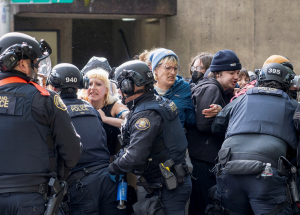President Joe Biden can ill afford a long, hot summer of protest that comes to a boil in time for the Democratic National Convention in August and then bleeds into the final weeks of an already venomous clash with Donald Trump.

After days of college campus demonstrations — triggered by outrage at the civilian carnage from Israel’s war in Gaza — the president’s reticence to throw himself into the politics of a perilous situation finally became unsustainable, resulting in his first on-camera comments on Thursday.
The nationwide campus protests are not as pervasive as mass civil rights and anti-Vietnam War protests that raged in the 1960s and 1970s. And this year’s fervor may cool when finals are over and students head home. But in stepping to the White House podium, Biden assumed a role adopted by many of his predecessors at moments of high tension. He tried to remind the nation of its core principles and the citizenry of their duty to uphold them to ensure that both the right to free expression and the rule of law prevail. He argued that just as people have the right to protest government policies, others have the right to get a degree on campus in safety and not to be racially slandered.
“I understand people have strong feelings and deep convictions,” Biden said. “In America, we respect the right and protect the right for them to express that. But it doesn’t mean anything goes. It needs to be done without violence, without destruction, without hate, and within the law.”
Biden’s political isolation
In a political sense, Biden’s speech was an act of fence sitting. He needs to avoid further alienating young, progressive voters who are furious about his handling of the Gaza war and could doom his reelection hopes if they don’t show up in November. But he must also ensure that more middle-of-the-road voters aren’t convinced by Trump’s claims the country is on fire and spinning out of control. Any time a sitting president looks like he’s observing rather than controlling inflammatory events, he’s taking a huge political risk. This is especially the case when a political opponent, in this case Trump, is lambasting him as weak and not up to the job.
James Traub, a columnist for Foreign Policy and the author of a new book about Hubert Humphrey, said Biden faced a similar dilemma as the former vice president who was the Democratic nominee in 1968 amid the domestic angst caused by the Vietnam War. Biden “has such a narrow path to tread that I think he said the right thing and did as well as he could do,” Traub told Isa Soares on CNN International on Thursday. Traub argued that Biden could lose “whatever connection he has to the energy and idealism of young people” if he criticizes the protesters but could alienate more moderate voters if he validates them.
Biden’s optics problem may be exacerbated by his own lack of engagement in the Vietnam-era activist movement. He told reporters in 1987 that “by the time the war movement was at its peak, I was married, I was in law school, I wore sports coats.” It’s hard to believe now, but America’s oldest president was once of the youngest senators in US history. But he was not a natural protester. His way was always to seek change through establishment politics and legislating. He’s got more kinship with the labor movement than the protest movement. According to the late columnist Mary McGrory, who was at the 1987 news conference, Biden said: “You’re looking at a middle class guy, I am who I am. I’m not big on flak jackets and tie-dye shirts — you know, that’s not me.”
That same conventionality was evident in Biden’s remarks decades later in Thursday.

